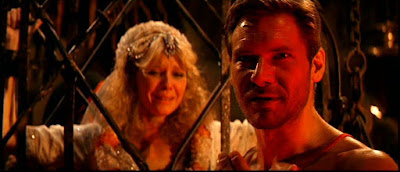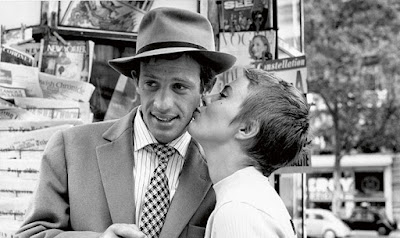In "Raiders of the Lost Ark," moviegoers were first introduced to archeologist Indiana Jones (Harrison Ford), the film's reluctant hero who successfully managed to outsmart the bad guys, save girlfriend Karen Allen from villainous clutches and during the final reel, uncover the mysterious Ark of the Covenant.
The film, one of the best escapist adventures of its kind, was stylishly directed by Steven Spielberg. And Lawrence Kasdan's screenplay recalled those magical action adventure serials of the 1940's, known for their effective cliffhanger devices.
(New Heights)
"Indiana Jones and the Temple of Doom" takes the stalwart, often cynical adventurer to new heights of excitement. But the film, directed by Steven Spielberg, is not a sequel to the 1981 box-office smash. Instead, the film is set in 1935, prior to Jones' discovery of the legendary Ark and its mystical powers.
The story, written by Willard Huyck and Gloria Katz, is simple enough. Jones and his two companions, a Chinese youth named Short Round (Ke Huy Quan) and Willy Scott (Kate Capshaw), a sexy nightclub singer, travel to India to rescue hundreds of children kidnapped from a distant village by the Mararajah's sinister high priest and his brainwashed followers. Naturally, they are unaware of the dangers that await them.
(Brilliantly Directed)
Like "Raiders of the Lost Ark," the film is brilliantly directed by Steven Spielberg, who clearly understands the meaning of motion picture escapism. It is patterned after the old movie serials of the 1940's. This concept, though familiar, again contributes to the film's enjoyment and makes "Indiana Jones and the Temple of Doom" just as enjoyable as its predecessor.
Because this cliffhanger process is so effectively executed by Spielberg, the audience is continually swept up in the action, gasping, covering their eyes, jumping out of their seats from shock or applauding madly as Jones battles the bad guys and escapes each peril by the skin of his teeth. When the film concludes, your're covered, as Spielberg intended, with sweat.
The screenplay incorporates many escapist plot devices that enhance the story's visual appeal. Unlike "Raiders," the film opens with a deliciously entertaining parody of 1930's musicals (the song "Anything Goes" is sung in Chinese by Kate Capshaw). Shortly after, one of the film's best chase sequences is staged.
First, Indiana Jones must contend with a nightclub brawl. Then, he and Willie jump out the window and conveniently fall through roof-like awnings into a moving car, driven by Short Round. Next, they board a cargo plane, triggered to crash. What follows is a toboggan ride down the ski slopes, topped off by a dangerous trek down the rapids. Unbelievable!
(Just the Beginning)
Remember, all those deadly snakes in "Raiders." This time, it's thousands of creepy insects in a dimly-lit cave.There's also a hilarious banquet scene with a menu consisting of live snakes, huge bugs, eyeball stew, and, for dessert, monkey brains. That scene alone is worth the price of admission.
The last half hour of the film which involves Jones' escape from the Temple of Doom is another of those escapist situations that demonstrate Spielberg's keen eye for staging action. Technically, it is
mind-boggling and carried off with the utmost conviction.
(Ford Sharp Again)
Reprising his role of Indiana Jones, Harrison Ford again captures the character's fine swashbuckling style, his sardonic wit, reluctant heroism and rugged sensuality. Like all screen heroes, he is a definite ladies man, something Ford has no trouble projecting.
Kate Capshaw's portrayal of Willie Scott is wonderfully comedic and refreshing. The sexual tension between she and Ford in nicely shaped under Spielberg's direction.
If you're looking for old-fashioned escapist entertainment, "Indiana Jones and the Temple of Doom" never lets you down. Spielberg makes it a four-star treat.
(This review was originally published on May 23, 1984)









No comments:
Post a Comment